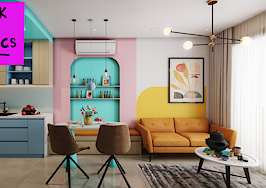 September is Marketing and Branding Month at Inman. Tips for better branding and in-depth features on how to take advantage of marketing tools provided by Zillow, Redfin and other platforms are all in the works in addition to insights from experts. You’ll find it all at Inman, as well as our two-day virtual, flagship event, Your Playbook for the Fall Market, in October.
September is Marketing and Branding Month at Inman. Tips for better branding and in-depth features on how to take advantage of marketing tools provided by Zillow, Redfin and other platforms are all in the works in addition to insights from experts. You’ll find it all at Inman, as well as our two-day virtual, flagship event, Your Playbook for the Fall Market, in October.
This article was last updated Sep. 8, 2022.
Imagine telling a wealthy client that their meticulously designed luxury estate is, well, not quite ready for prime time. According to Lisa Hynes, owner and CEO of Stage to Show, this is where the service of a luxury staging expert can pay dividends.

Lisa Hynes
“What I do for the agent or broker is to play the bad cop,” she said. “The broker has to have the long-term relationship with the client. I try to protect that relationship and play the bad guy even though I do it in a gentle way. I can walk through and say, ‘I love this, but not everybody wants a pink living room.'”
For the most successful luxury agents, stellar luxury staging designers’ services are essential, helping to position the home for the market’s most demanding buyers. Find out the secrets of luxury staging and why it matters so much to brokers, sellers and buyers.
Table of contents
- What differentiates luxury staging?
- Does the home need to be staged?
- What are luxury staging guidelines?
- Can clients partially stage?
- Is staging for virtual tours different?

Courtesy of IMG
What differentiates luxury staging?

Mara Flash Blum
Again and again, the luxury agents and designers we spoke with reiterated that attention to detail makes luxury staging unique.
According to Mara Flash Blum of Sotheby’s International Realty Downtown Manhattan Brokerage, a luxury stager may do any or all of the following in addition to bringing in new furniture and artwork:
- Refurbish the flooring and stain it a different color
- Change paint and wallpaper
- Paint kitchen cabinets
- Switch out light fixtures
- Switch out drawer pulls and cabinet knobs
- Remove heavy curtains
- Order new towels and bed linens
- Curate bookshelves
Blum says that the goal is to create a decluttered and neutralized space so that potential buyers “see the merits of the space and not the specifics of the decorating.”
Eric Lavey of Sotheby’s International Realty Beverly Hills Brokerage says that luxury staging involves an accurate understanding of the luxury buyer’s expectations.

Eric Lavey
“I want [buyers] to walk into a home and see the same style that they are going to see in the pages of Architectural Digest, Interior Design Magazine or House Beautiful,” he said. “Even if they won’t live that way or buy that exact furniture, it’s an aspirational target. Luxury is more of a lifestyle and a frame of mind.”
Blum offers one exception when luxury staging may not be necessary: “Beautifully decorated homes designed by a notable architect should be left ‘as is’ and marketed to those potential purchasers who are looking for that specific aesthetic.”

Additional resources:
- Inman handbook: Breaking into the world of luxury real estate
- Inman Handbook on building a luxury brand
- 6 tips for standing out as a luxury real estate agent
- Want to make your mark in luxury? Conquer these essentials
Does the home need to be staged?
Although many luxury homes are beautifully decorated, they might not be buyer-ready. Even if filled with high-end pieces, it’s essential to determine whether those pieces — and the home’s overall look — are right for the space and the market.
Caliber
One of the most important aspects of choosing furnishings, accessories and artwork for a space is ensuring that it’s of the same caliber as the home itself. Luxury buyers are hyper-aware of the “right” brands and decorative elements. Putting an item of inferior quality into a luxury home calls into question the quality and taste level of the house itself.
Condition
Even if professionally designed, the furnishings might have become worn and “lived-in” over the years. Some of the elements might be older or reflect a dated aesthetic that is out of keeping with current luxury design trends.
Renewal
Sometimes, staging is vital to refresh or reposition the listing’s marketing. “If the listing has been on the market before with another broker, it would be best to reinvent it with a new look before relaunching on the market,” Blum said.
Aesthetic
The home might need staging to ensure that the interior design aesthetic matches the style of the house. “We try to respect the integrity of the house and furnish the house based on the style, whether it’s colonial, Tudor, modern or industrial farmhouse,” Hynes said. “It’s not that we’re putting colonial furniture into a colonial home, but we will think about the house and the neighborhood when choosing the style.”
Eccentricity
If the home drips in the owner’s highly individual taste, staging might be essential.
Blum said the home should be staged if it “has been decorated with strong vibrant colors or has art that is provocative.” Also, depersonalization is generally a goal so that potential buyers can envision themselves in the space.

Additional resources:
- How to be a master of fine arts in luxury real estate
- This season’s hottest design trend is a blast from the past
- 10 things your home stager better know
- 5 critical steps to maximize your listing’s sales potential
What are luxury staging guidelines?

Cheryl Eisen
Cheryl Eisen, founder and president of Interior Marketing Group (IMG), is an award-winning celebrity interior designer and a home staging pioneer. She and her team recently launched IMG | Home, a home decor line featuring accessories and statement pieces that reflect her signature style.
Eisen looks at the following elements when staging a luxury property:
Details
“I think the biggest difference is creating a complete home from head to toe, even down to the smallest details like soaps and products in the bathrooms,” Eisen said. “Luxury clients are typically some of the most discerning people out there and have specific lifestyle expectations.”
Eisen said that staging isn’t just about “spatial reasoning — it has to overwhelm the buyer with a full lifestyle experience of the quality and level they’re accustomed to.”
Functionality
Eisen focuses on function and aesthetics when designing a space — zeroing in on how that space can and should be used in day-to-day life. “Is this a smaller balcony where a couple would enjoy a cup of coffee, or are we looking to create an outdoor entertaining space that can fit family and friends?” she said.
The design should inspire the buyer to utilize the space and maximize its potential, Eisen said. This type of aspirational design aligns potential buyers with the property and allows them to vividly imagine themselves in the space.

Courtesy of IMG
Refresh
“Just like the price and positioning of a property, it’s important to reevaluate the look of a home after some time on the market,” Eisen said. “It’s often a collaborative process with the broker where we discuss buyer feedback and how we can potentially make the home more attractive.”
“Should the office we created be a nursery? Did we go too feminine or close to one particular style? Should we stage the outdoor space now that it’s getting warmer?” These types of questions offer the designer and the broker an opportunity to update a home based on early feedback.
Rendered-to-Reality
IMG and Eisen’s service, Rendered-to-Reality, is a virtual staging service that allows brokers and their clients to go to market in a matter of days with a virtual version of the eventual home-staging design.
“While they advertise and schedule showings, we’re able to install the exact digital design in real life,” Eisen said. “But the best part is that buyers can purchase everything they’ve fallen in love with directly from our digital designs or in-person installations.”

Additional resources:
- How trendy is ‘too trendy’? Making the latest design work in your space
- 10 common staging mistakes that could hurt your listing
- 3 artful tips on how to stage a vacation home this summer
- 9 tips to transition into seasonal decor buyers will fall for
Can clients partially stage?
It is not always possible to stage an entire home, though it is preferable. Depending on the home’s square footage and the client’s preference, it might be necessary to do only part of a luxury property.
Hynes said determining the scale of the staging “is a fine line. Half of the houses we stage are occupied, and they love their floral sofa or their hunter-green walls, and that’s one of the challenges. It’s not what I like or what the broker likes or what the homeowner likes — it’s what the market is asking for, which is a more transitional, streamlined style.”
Blum said that some sellers say “no” to full staging, so partial staging becomes necessary. However, this “does not lead to the best results. Most purchasers cannot envision how they would design the rest of the property.”
Staging one floor of a multifloor property can help. Still, neglecting the outdoor spaces or oddly shaped interior rooms can result in the property taking longer to sell or selling at a lower price because buyers think the home needs additional upgrades, Blum said.
Lavey also mentioned the importance of exterior staging, especially in his Southern California market. “Our outdoor spaces are as important as anything else because we use them a lot. A lot of our properties are blended indoor/outdoor spaces with walls of glass that open up. If they’re not designed and staged properly, it falls apart, and the value of the space isn’t realized.”

Additional resources:
- 5 holiday home-staging ideas for your sellers
- 4 home design trends sure to make potential homebuyers swoon
- 8 tips for virtually prepping a home for sale
- Why getting the Pinterest look in your listings matters
- 8 outdoor trends homebuyers can’t help but love
Is staging for virtual tours different?
As Eisen and her team have found, virtual staging is sometimes necessary to meet client preferences or timeline and budgetary constraints. To ensure a home looks its best on camera, it’s important to go even further with some of the elements of your staging. These include:
Lighting
For the home to show its best, everything needs to be well-lit and lightened up. That means that you throw open the curtains, turn on every light, and bring in additional lighting as needed to ensure the home looks as bright and cheerful as possible. You may also want to use lighter-colored furniture and rugs or mirrors to reflect more light throughout the space.
Decluttering
Decluttering is always important for staging, but it is essential for video tours. Everything that is out of place is more noticeable and can be reviewed and picked repeatedly. Kitchen counters, bathroom vanities and bookshelves all look more crowded and messy. Put away anything that isn’t necessary, and adopt a minimalist aesthetic for surfaces.

Courtesy of IMG
Coherence
It is essential to orient the viewer with the space by looking for ways to show it within a frame. Frame a room in the doorway, or look for specific seating areas rather than offering a jumble of perspectives. Allow the viewer to fully take in the details of one space before moving into another.
Outdoors
Don’t forget outdoor spaces, including the views from the living room and bedroom windows. You might also be including drone footage for an overview of the property’s exterior features, but potential buyers will want an up-close-and-personal view of these spaces as well.
Sound
Noises that might not register in person can become distracting and frustrating when viewed on video. Minimize the noise from fountains or water features while you’re talking, and ensure that no one in the home is chatting in the background while you’re conducting the tour.

Additional resources:
- Light it up! 6 tips to make your home staging shine
- Home staging can be done virtually — here’s how
- Doing virtual tours? 10 things you should (and shouldn’t) do
Christy Murdock is a Realtor, freelance writer, coach and consultant and the owner of Writing Real Estate. She is also the creator of the online course Crafting the Property Description: The Step-by-Step Formula for Reluctant Real Estate Writers. Follow Writing Real Estate on Instagram.













